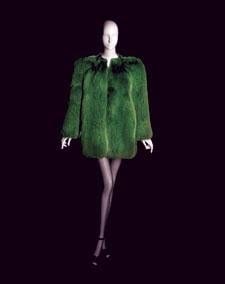When Yves St Laurent died in June, my friend held a memorial, which consisted of us watching David Teboul’s 2002 film Yves St Laurent: His Life and Times, a prosaic documentary that encompassed the designer’s career from his beginnings to his retirement. The film opens with an interview with the contemporary St Laurent, recognizable from media imagery — the gruff man with the big black glasses (the only thing that was missing was Catherine Deneuve hanging off his arm). Then the film flashed back to archival footage from the late 1950s. Here was someone entirely new: the young Yves, a newly minted superstar of “Le Style Français,” a certified nelly — reedy, shy, kittenish, an awkward 21-year-old who smiled nervously, hands clasped limply by his neck, breezing through his atelier wearing a blousy doctor’s coat. He still had the same glasses, though.
St Laurent was born in the French colony of Oran (now Algeria), moving to Paris when he was 17. An avid drawer, he showed his sketches to Michel de Brunhoff, then-editor of Vogue, who published them on the spot. When St Laurent tired of fashion school after a few months, de Brunhoff introduced him to Christian Dior. He quickly bonded with Dior, and when he died suddenly in 1957, St Laurent inherited the house at the ripe old age of 21. It took him four years to completely take over the French fashion world.
After saving the almost-bankrupt house of Dior with his first show as designer, the theatrical and wildly popular 1958 Trapeze collection, his collections strayed ever further from the staid elegance that was expected of couture. In a bizarre act of subterfuge, the administrators of Dior lifted St Laurent’s exemption from national military service and he was drafted to fight in the Algerian War. The delicate St Laurent didn’t last three weeks. The hazings and general brutishness (maybe if he idolized Jean Genet instead of Marcel Proust, he might have fared better) sent St Laurent into a mental institution for a nervous breakdown, where he underwent electroshock therapy. He emerged in 1962, his contract with Dior now terminated. With the help of his lover Pierre Bergé and an American investor, he launched the Yves St Laurent label. The rest is history.
Most of us rarely experience fashion, especially haute couture. It’s one thing to hear or read about St Laurent’s brilliance, but unless you actually see the clothes, what does that even mean? The current St Laurent retrospective at the Montreal Museum of Fine Arts offers room after room of gowns, dresses and suits that ooze fabulousness. These clothes are art. Just like a slide of an artwork is no replacement for the real thing, images of St Laurent’s work pale in comparison to standing in front of it.
First of all, these are not clothes. You and I wear clothes, utilitarian things with pockets and seams and washing instructions that fade and sag and fray. St Laurent made style. These dresses, despite the fact that they represent hours and hours of labour by a roomful of highly skilled seamstresses (did you really think St Laurent could sew?), look like they just appeared in a poof of sublime glamour.
All of the highlights are here: gowns seemingly made entirely of peacock feathers, the Mondrian-inspired slip dress (which I always thought was a print, but no: it’s made up of panels of fabric — I defy you to find a seam in that thing). Even Le Smoking, a women’s tuxedo, arguably his most famous creation, is here. Looking at it, all this talk of St Laurent revolutionizing the way women dressed begins to make sense. A man’s suit is meant to make him look like architecture, all flat planes, angles and lines. St Laurent’s Le Smoking, on the other hand, looks like champagne being poured out of a bottle.
I couldn’t imagine anyone wearing these creations; if anything, they wear you (although I suppose it helps to be a preternatural beauty like Deneuve, or his later muse, supermodel Laetitia Casta). These things need to be appreciated through careful scrutiny. How could you marvel at the exquisite beading on a bolero jacket made to look like a Van Gogh painting if the person wearing it is sashaying around a room? In that sense, St Laurent’s vision is wildly optimistic: Judging from the staggering gorgeousness of his huge output, he must have believed that people were meant to be swathed in such sublimity. Well, the women who could afford it, anyway.

 Why you can trust Xtra
Why you can trust Xtra


